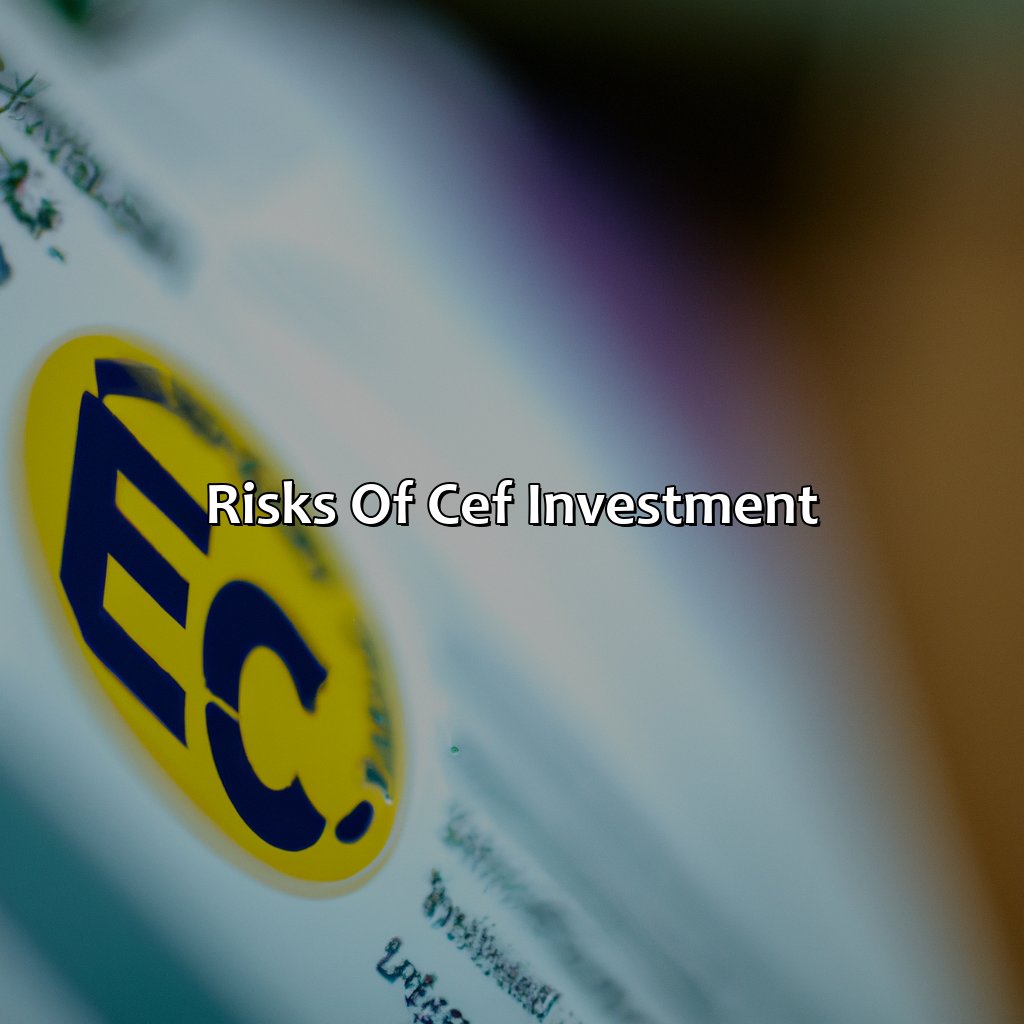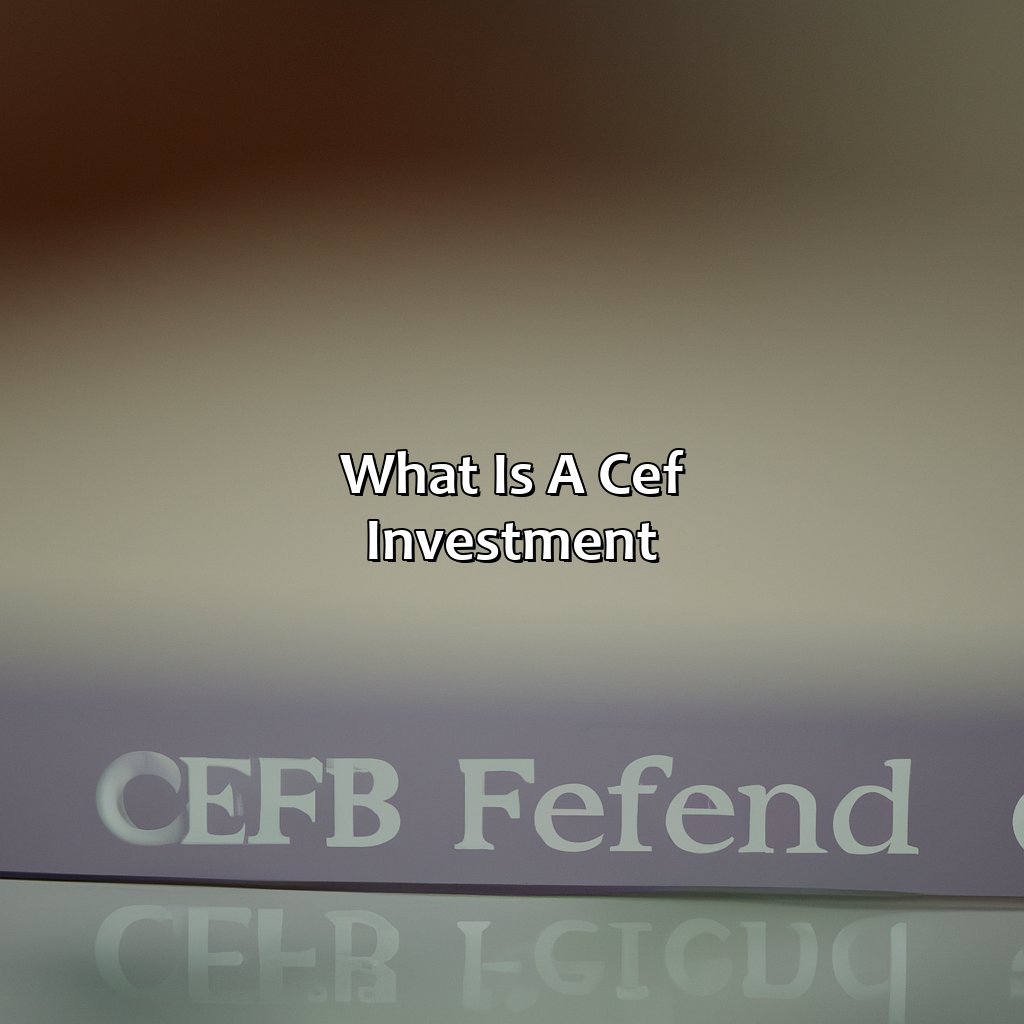What Is A Cef Investment?
Key Takeaway:
- A CEF (Closed-End Fund) investment is a type of investment that pools money from multiple investors to buy a diversified portfolio of stocks or bonds. Unlike traditional mutual funds, CEFs have a fixed number of shares, and investors can only buy or sell shares on a stock exchange.
- There are two main types of CEF investments: equity-based CEFs, which invest in a diversified portfolio of stocks, and bond-based CEFs, which invest in a diversified portfolio of bonds.
- CEFs offer several advantages, including diversification, high dividend yield, and professional management. However, investors should also be aware of the risks associated with CEFs, including market risk and leverage risk.
Do you want to make a wise investment decision but aren’t sure where to start? CEF investments offer a unique opportunity to potentially grow your money. Learn more about this investment vehicle and the potential rewards it could offer you.
What is a CEF investment?
A Closed-End Fund (CEF) investment is a type of investment fund characterized by its limited number of shares and its structure of being traded on an exchange like a stock. CEFs issue a finite number of shares, which are then traded on an exchange, so the price of the shares can fluctuate. CEFs often invest in a mix of debt and equity securities, which can make them a potentially valuable tool for both passive and active investors.
In terms of their structure, CEFs are similar to mutual funds, but they differ in two key ways. First, CEFs are traded on an exchange, which means that their shares can be bought and sold like stocks. Second, CEFs have a fixed number of shares, whereas mutual funds can issue new shares to meet investor demand. These characteristics make CEFs more similar to exchange-traded funds (ETFs) than mutual funds.
CEF investments can be a great way for individuals to invest in a diverse portfolio that is managed by a professional team. They can also provide investors with access to niche markets that might not be otherwise available. However, like any investment, CEFs come with their own set of risks, so it is important to do your due diligence before investing.
Many famous investors have used CEFs throughout history, including Benjamin Graham, Warren Buffet, and Peter Lynch. By investing in CEFs, these investors were able to gain exposure to different markets and asset classes, and potentially earn higher returns than they would have with more traditional investments. Overall, CEFs can be a valuable tool for investors looking to diversify their portfolios and take advantage of unique investment opportunities.

Image credits: retiregenz.com by David Duncun
Types of CEF investment
Gain insight into CEF investments. Check out the various types available. To invest in a CEF, figure out which type fits your investment goals. Popular options include equity-based and bond-based CEFs. Each has its own special traits and benefits.

Image credits: retiregenz.com by Harry Woodhock
Equity-Based CEFs
Following the Differentiated CEFs, Equity-Based CEFs represent another form of investment. These funds invest in equity securities, including common and preferred stocks. Equity-Based CEFs can be classified by various metrics like geographic location, market capitalization, or industry sector.
In this type of fund, investors would gain exposure to a diversified portfolio of equities, which reduces risk compared to buying individual stocks. Equity-Based CEFs have potential for growth and also offer passive income through dividends.
A unique feature of Equity-Based CEFs is their ability to use leverage to amplify returns; however, it’s worthwhile to note that this amplification comes at the cost of increased risk and volatility.
During the Global Financial Crisis in 2008/09, several equity-based closed-end funds suffered significant negative financial impacts on their holdings due to elevated leverage levels. As a result, many investors incurred substantial losses on those investments.
Looks like Bond-based CEFs are not just for James anymore, even investors can enjoy a piece of the action!
Bond-Based CEFs
Investing in Closed-End Funds (CEFs) that revolve around bonds as their primary asset class can be categorized under Fixed-Income Based CEFs. These funds aim to generate a steady stream of income for investors by investing their capital directly into fixed-income securities, including government, municipal, and corporate bonds.
Furthermore, Bond-Based CEFs often implement capital growth strategies by including dynamic investment practices such as interest rate hedging to maximize investor returns. Bond-Based CEFs are an essential part of a well-diversified investment portfolio, particularly for conservative or risk-averse investors who prioritize capital preservation over aggressive growth.
In addition to this, the perks offered by such investments provide high yields compared to open-end mutual funds in terms of monthly income distribution. Such an advantage is achieved through relatively higher credit quality preservation since these investments have a scheduled maturity date of the respective securities included in the fund.
Do not miss out on investing in Fixed-Income Based CEFs such as Bond-Based as they guarantee attractive returns backed with minimal volatility. One may consider adding them to their long-term investment portfolio underneath expert guidance for optimal benefits.
CEF investments – because sometimes it’s good to have your portfolio diversified by professionals, especially when your idea of diversification is buying different colors of Monopoly money.
Advantages of CEF investment
CEF investment has advantages! Let’s dig deeper. Diversifying, high dividend yield, and professional management makes it attractive to investors looking for a balanced portfolio. Let’s explore how these advantages could benefit you. Boom!

Image credits: retiregenz.com by Adam Woodhock
Diversification
Investing in CEFs provides a wide range of assets that are diversified, enabling investors to spread their investment risk. By investing in different sectors, types of assets, and geographic regions, not only can investors mitigate their risk but also increase the potential for higher returns. This level of diversification is unmatched by individual securities or mutual funds.
In addition to diversification benefits, investing in CEFs offers attractive discounts to net asset values (NAVs), which means that investors can acquire shares at lower prices than the actual value of the underlying assets. Moreover, some CEFs provide high yields in the form of dividends and distributions due to their structure concerning income generation and distribution.
Importantly, as with all investments, there are risks associated with investing in CEFs. For instance, investments must align with investors’ long-term objectives and tolerance for risk. Due diligence is also important; each fund’s portfolio and past performance need scrutiny before making an investment decision.
For instance, consider an investor who bought a CEF that invests in a diverse range of stocks from different sectors such as technology and healthcare. During an economic downturn when most tech stocks are facing losses due to decreased consumer spending on technology products, this investor’s healthcare stocks would offset their losses from tech stock returns. Thus having the diversification advantage through purchasing a single share in a CEF that has many holdings could focus on mitigating sudden exposure faced by an individual investment in one sector or stock during market volatility situations.
CEFs: Where you can finally earn more in dividends than your ex’s lawyer.
High Dividend Yield
Investing in a CEF can provide investors with impressive dividend payouts, resulting in a Higher Yield on Investment. Closed-End Funds (CEFs) are known for their attractive yields, which typically surpass the yields of mutual funds and ETFs. Due to their unique structure, CEFs can often leverage up portfolios, leading to higher income generation. Investors may also enjoy condensed real-time market activity and holdings that reflect various asset classes.
Furthermore, CEFs can continuously pay out dividends, even during periods of market volatility, provided that the underlying asset values remain stable. This feature makes them a useful tool for individuals who depend on recurring investment income.
To maximize the benefits of investing in a CEF with High Dividend Yields, consider looking at those which invest in multiple asset classes or sectors. Diversification helps mitigate risk and ensure more substantial yield payouts than Single Sector funds. Also, check out funds that maintain reasonable expense ratios to avoid excess fees eating into your returns. By keeping these factors in mind while selecting your investment options, you can achieve robust yields while also managing risk levels appropriately and meeting financial goals efficiently.
Leave the management to the pros, unless you enjoy losing money like it’s your job.
Professional Management
Investing in Closed-End Funds (CEFs) offers the advantage of Professional Portfolio Management. The fund managers are experienced and have the skillset and expertise to actively manage the portfolio and make investment decisions on behalf of investors.
The role of these experts is crucial in deciding which assets to buy, hold or sell. They conduct in-depth research and analysis, keeping close tabs on market movements and trends, identify sectors with potential growth opportunities, undertake risk assessments, and maintain a diversified portfolio for optimal returns.
Moreover, investors benefit from economies of scale thanks to pooled resources. CEFs can afford specialized research teams who track various markets globally, enabling them to invest across different asset classes – stocks, bonds or commodities – without requiring significant starting capital from individual investors.
In Q1 2021, CEFs’ net issuance hit $5.99B – their highest quarterly total since Q3 2014 – according to Refinitiv Lipper data.
Therefore, when considering investments that offer professional management and diligent oversight while providing access to diverse assets across the globe at reasonable costs- closed-end funds should be considered as an attractive option. Putting all your eggs in one basket may not be wise, but putting all your money in a CEF investment? That’s just asking for a rollercoaster ride of emotions.
Risks of CEF investment
Mitigate risks of investing in CEFs? Essential to learn market and leverage risks. Examine market risks, understand how it affects your investment. Check leverage risks to know associated risks of borrowing funds to invest.
Market risk sub-section: Fluctuation of market, how it impacts your investment.
Leverage risk sub-section: Risks related to borrowing for investment.

Image credits: retiregenz.com by Joel Washington
Market Risk
The potential for a downward shift in the market is known as Market Risk. It is a type of systematic risk that can impact all securities and asset classes, including closed-end funds (CEFs). CEFs, like most other investments, are influenced by market fluctuations that can reduce their prices and returns. The sensitiveness of CEFs to market volatility hinges on the underlying asset allocation and management techniques used.
Since multiple components influence the value of CEF shares, it is difficult to predict how much they would drop in contrast to an underlying index or benchmark during bear markets. Each fund will have its management strategy, and each investor should conduct thorough research before selecting a fund. Investors may seek out skilled managers who have demonstrated consistent performance over various market conditions to decrease their exposure to sudden swings.
While catastrophic falls are rare events, closing prices can fluctuate significantly every day due to even small changes in industry news or sentiment. Significant intraday price swings may result from high-frequency electronic trading; hence it’s tough to evaluate when market volatility will affect an investor’s portfolio meaningfully. Investors must exercise caution in managing their portfolios by diversifying across several asset classes and distributing risk evenly across investments.
Investors that stick to their long-term investment approaches despite transient risks are more likely to succeed over time. In order words, investors should not rush into purchases based on short-term trends; instead, they should weigh up long-term objectives before investing in appropriate funds with acceptable levels of investment risk adjusted for an investor’s risk tolerance capacity.
A well-planned investing plan combined with diversification may help mitigate the dangers associated with investing in CEFs vulnerable to periodic market fluctuations. Don’t be like a cat with a loaded gun, steer clear of leverage when it comes to CEF investment.
Leverage Risk
Investing in CEFs comes with a significant threat being described as financial magnification jeopardy. It is prominent and distinctive, and it involves exhausting acquired funds as credit to enlarge the profit from an investment. In simpler terms, leverage risk is the peril associated with using borrowed capital to enhance one’s profits when investing.
This form of risk requires management expertise. When managed poorly, it could cause disaster for investors who increase their exposure to this type of product too much. However, some people prefer taking risks because of the uncertainty and possibility of achieving high yields in the market.
It’s worth noting that leveraging has happened before, and scholars tie its occurrence to events like the Great Depression or 2007-2009 worldwide economic crises, which caused massive losses due to imbalanced leveraged exposure in portfolios.
CEF investing presents additional concerns such as market volatility or unforeseen circumstances. Investors must tread carefully when adding a leveraged product into their portfolios because they run the risk of seeing significant losses if not handled correctly.
Five Facts About CEF Investments:
CEF stands for Closed-End Funds, which are investment companies that raise capital through an IPO (Initial Public Offering) to establish a closed pool of assets managed by a portfolio manager. (Source: Investopedia)
CEFs generally trade on stock exchanges like regular stocks, and can either be bought or sold through a brokerage account. (Source: Seeking Alpha)
CEFs differ from open-end funds (e.g., mutual funds) in that they have a fixed number of shares and do not issue new shares to meet investor demand, and they typically issue a dividend or interest payment to shareholders. (Source: The Balance)
CEFs can invest in a variety of asset classes, including stocks, bonds, and other securities, and can use leverage to enhance returns. (Source: Forbes)
CEFs can offer a way for investors to gain exposure to certain asset classes or sectors that may be difficult to access otherwise, and they can also offer diversification benefits. (Source: U.S. News & World Report)
FAQs about What Is A Cef Investment?
What is a CEF Investment?
CEF stands for Closed-End Fund, a type of investment company that has a fixed number of shares and trades like a stock on an exchange. A CEF invests in a diversified portfolio of securities, such as stocks, bonds, and other assets, and distributes the income it earns to shareholders in the form of dividends. Unlike open-end funds, CEFs do not issue or redeem shares on a daily basis. Instead, investors can buy and sell shares of a CEF like a stock through a brokerage account.
How does a CEF differ from other types of investment funds?
CEF differs from other types of investment funds in several ways. CEFs typically have a fixed number of shares, which are traded on a stock exchange, while open-end mutual funds issue and redeem shares on a daily basis. Also, CEFs may use leverage, called a managed distribution policy, to pay out higher dividends to investors. Another difference is that CEFs tend to trade at a discount or premium to their net asset value, while open-end funds trade at their NAV.
What are the benefits of investing in a CEF?
CEF investments offer several benefits, including the potential for high income through higher dividend yields, the ability to diversify a portfolio with a single investment, and access to professional management, which can help maximize returns for investors. In addition, CEFs may provide investors with capital appreciation, potential tax advantages, and reduced transaction costs.
What are the risks of investing in a CEF?
As with any investment, CEFs carry inherent risks. These may include market risk, interest rate risk, credit risk, and liquidity risk. In addition, CEFs may use leverage, which can amplify both gains and losses. Furthermore, CEFs may trade at a discount or premium to their NAV, which can affect the price of shares. CEFs are also affected by changes in market conditions and economic factors, which can impact their performance.
How do I select a CEF investment?
When selecting a CEF investment, investors should consider several factors, including the investment objective of the fund, its historical performance, management team, fees and expenses, and the level of risk involved. In addition, investors should review the fund’s prospectus, which provides detailed information about the fund’s investment strategy, risks, fees, and other key features.
Should I invest in a CEF?
Whether or not to invest in a CEF depends on an individual’s investment goals, risk tolerance, and overall portfolio strategy. CEFs can provide many benefits, such as income, diversification, and professional management. However, they also carry risks, and investors should carefully consider these factors before investing. Investors should also consult with a financial advisor to determine whether a CEF is a suitable investment for their specific situation.
 Checkout this IRS Loophole
Checkout this IRS Loophole 
